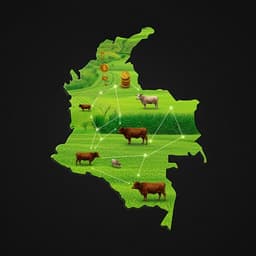
Economics
Analysis of the agricultural economic value of a weather forecasting service based on a survey of peasant households in Chinese provinces
D. Shen, X. Zhao, et al.
Discover how weather forecasting services can significantly boost the income of farmers in China. This research, conducted by Danna Shen, Xiaofeng Zhao, Leyi Chai, Zhuanzhuan Guo, and Chunxiang Leng, reveals that each additional access channel to weather forecasts increases farmers' income by 11.11 yuan while also leading to notable cost savings.
~3 min • Beginner • English
Introduction
As global climate change worsens, recurrent extreme meteorological events threaten food security. China, in the East Asian monsoon region, is highly vulnerable to agrometeorological disasters. Over the past decade, average annual crop losses exceeded 9 million hectares, with direct economic losses around ¥300 billion annually and roughly 230 million people affected each year. Despite frequent disasters, enhanced meteorological forecasting services and early warnings have reduced affected areas, impacts, and fatalities in rural areas. Strengthening weather forecasting can help farmers withstand extreme events, build resilience, and reduce poverty. However, quantifying the agricultural value of weather forecasting services remains challenging. This study uses a nationwide household survey and regression analysis to evaluate how meteorological forecasting services affect agricultural income increases and cost reductions in China.
Literature Review
Prior quantitative research has evaluated the agricultural value of meteorological forecasts in specific regions. Solow et al. (1998) found improved ENSO forecasts could add an estimated $323 million annually to U.S. agriculture. Hyung et al. (2014) used a coupled climate–crop–economic model for Spain, finding global benefits of $61–$189 million per year, with 0.8%–2.9% gains for consumers and 1.9%–7.0% increased farm income. Petersen and Fraser (2001) estimated seasonal forecasting could reduce seasonal uncertainty by ~30%, potentially increasing annual profits by ~5% in Western Australia. Pierre and Jean-Michel (2005) showed seasonal weather forecasts aid EU producers’ decision-making via yield simulations. Rebecca et al. (2020) highlighted that the usefulness of seasonal forecasts varies with technology and user application. Tesfaye et al. (2019) showed climate services strengthen resilience and adaptation among Ethiopian smallholders. Household survey approaches have been used to assess value and willingness to pay in the public sector: Roudier et al. (2014) found yield gains of about one-third in Senegal with climate prediction adoption; William et al. (2018) studied willingness to pay for weather-indexed insurance in West Africa; IFPRI’s Uganda survey (Ulimwengu and Sanyal, 2011) found farmers more willing to pay for aggregate services than individual projects. No prior study has used household surveys to examine China’s agricultural value of meteorological forecasting services, motivating this work.
Methodology
The study combines theoretical analysis, a nationwide household survey, data processing, and econometric modeling. Theoretical framework: Two mechanisms are posited—(1) cost savings from optimized factor inputs (labor L, fixed capital K2/machinery, liquid capital K1/agricultural inputs) when forecasts inform decisions, represented by expected additional inputs absent forecasts and their prices; and (2) income gains from proactive actions based on forecasts, represented as output differences with and without attention to weather forecasts (WF=1 vs WF=0), net of additional inputs. A cumulative income increase equals output-based gains plus cost reductions, conceptualizing three production states: baseline without forecast (C0, F0), a virtual state with actions that hold output constant (C1, F0) reflecting cost savings, and a state with increased output from full use of forecasts (C2, F2). Survey design and data: A household questionnaire focused on farmers’ willingness to pay and the impacts of meteorological information. 5807 questionnaires were collected across 31 provinces and 1750 counties (respondents included agricultural producers, experts, and service personnel; main crops: corn, wheat, rice, rape, soybean). Information covered education, job nature, planting scale and area, costs and income per mu, input cost shares across production links, attitudes to forecast services, changes in unit-area costs before/after receiving forecast info, and willingness to pay for professional services. Data processing: Invalid samples excluded: completion time <1 minute; implausible cost structures (land, labor, materials, machinery each <1% of total input cost per mu); reported income increase per mu exceeding output value per mu; reported cost saving exceeding total input cost per mu; missing data. After cleaning, 3771 valid questionnaires remained. Quantitative responses often used intervals, replaced by interval medians unless a specific value was provided. Qualitative–quantitative combinations included selection of information channels (Internet/mobile, TV, agrometeorologist, village radio, radio, newspaper). Variables constructed: InfoSourceWidth (number of channels used) and per-channel dummies; ConcernWidth (number of production links where forecasts are considered—e.g., seeding only =1; seeding, fertilization, irrigation =3). Econometric models: Multiple linear regression with cluster-robust standard errors at the provincial level (Stata 16.0). Fixed effects: province, education, occupation. Cost reduction model (log form): log(CostReduction)i = α0 + α1 Landi + α2 log(Labori) + α3 log(CapitalConsti) + α4 log(CapitalLiquidi) + α5 Areai + α6 PriceCropi + α7 InfoSourceWidthi + α8 ConcernWidthi + Σj δj Jobij + Σp γp Provincep + Σe θe Edui + εi. Income increase models: (1) IncomeIncreasei = β0 + β1 Landi + β2 Labori + β3 CapitalConsti + β4 CapitalLiquidi + β5 Areai + β6 PriceCropi + β7 InfoSourceWidthi + β8 ConcernWidthi + Σj β9j Jobij + Σp β10p Provincep + β11 Edui + εi; (2) replacing InfoSourceWidth with six channel dummies (Internet/mobile, TV, agrometeorologist, village radio, radio; newspaper excluded in one specification due to collinearity).
Key Findings
- Positive association between attention to meteorological forecasts across production links and income growth: each additional production link where forecasts are heeded is associated with an average increase of 5.755 yuan per mu.
- Information access breadth matters: each additional forecast information channel (InfoSourceWidth) increases income by 11.11 yuan per mu on average.
- Specific channels: agrometeorologist and radio channels are significant, contributing approximately 18.22 yuan and 28.49 yuan per mu, respectively, to income gains; other channels (Internet/mobile, TV, village radio, newspaper) were not statistically significant in the detailed channel model.
- Cost reduction drivers: savings are significantly associated with factor inputs—labor, machinery (fixed capital), and agricultural inputs (liquid capital). Land input, planting area, and crop price did not show significant effects on cost savings in the narrative findings.
- Magnitudes of savings per standard deviation increase in inputs (at mean levels): labor 10.75 yuan, machinery 10.07 yuan, agricultural inputs 5.47 yuan; totaling 26.29 yuan of factor inputs saved per mu.
- Income determinants: in the income model, labor input and crop price were positively associated with income increases, land input negatively associated; R2 ≈ 0.187; observations ≈ 3770. Cost savings model R-squared ≈ 0.196; observations ≈ 3757.
Discussion
The study addresses the central question of whether and how weather forecasting services create economic value in Chinese agriculture. Results indicate that forecasts both increase income and reduce costs. Mechanistically, benefits arise from more efficient allocation of labor, machinery, and materials, and from timing-sensitive decisions (e.g., sowing, irrigation, pesticide application, harvesting, drying) that leverage forecast information. The breadth and frequency of information exposure amplify benefits: farmers who consult forecasts more often and via more channels realize larger gains. Heterogeneity in channel effectiveness suggests that dissemination modes tailored to user characteristics matter: radio and agrometeorologist channels, which suit middle-aged/elderly rural growers and provide expert interpretation, deliver larger gains than purely passive or less accessible channels like mobile internet. The findings validate the theoretical framework of factor input savings and output enhancement and underscore the importance of accessible, interpretable, and frequent meteorological information for agricultural decision-making.
Conclusion
Using a large-scale household survey across 31 Chinese provinces combined with regression analyses, the paper quantifies the agricultural economic value of meteorological forecasting services. Key contributions: (1) Demonstrates that attending to forecasts across production stages increases income by about 5.755 yuan per mu per link; (2) Shows that expanding the number of information channels raises income by about 11.11 yuan per mu per additional channel; (3) Identifies significant cost savings from labor, machinery, and agricultural inputs, with combined savings of roughly 26.29 yuan per mu at one standard deviation increases in inputs. Policy and practice suggestions include expanding and diversifying dissemination channels, improving user-friendly mobile interfaces, integrating agricultural service information into digital platforms, and delivering more professional, customized, and precise services and guidance across planting, storage, and circulation stages to further reduce costs and increase efficiency. Future work could explore link-specific impacts, user heterogeneity, and how to optimize channel mixes and content to maximize adoption and benefits.
Limitations
The study relies on self-reported survey data and hypothetical constructs regarding production states. Respondents may have limited knowledge of baseline production without forecasts (C0, F0), and the virtual state (C1, F0) is hypothetical. As such, reported income increases and cost savings reflect both objective impacts and respondents’ experiences and subjective attitudes. Interval-based responses were converted to medians unless specific values were provided, which may introduce measurement approximation. Collinearity led to exclusion of some variables (e.g., newspaper in one model), and results are conditioned on province, education, and occupation fixed effects.
Related Publications
Explore these studies to deepen your understanding of the subject.







